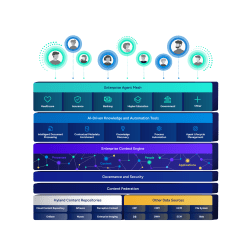4. Remote employees are fully supported
Healthcare may not come to mind first when you think of remote work, but during the pandemic employees that were not needed for clinical care often moved home, and physicians such as radiologists began to read patient images from home as well.
With space freed up and employees and clinicians satisfied with this arrangement, remote work is here to stay at many organizations. Video conferencing and messaging apps allow them to connect with others, and with cloud enablement, remote and in-the-field access can be provided from any location with an internet connection.
Cloud computing in healthcare enables health practitioners to gain secure access to patient records and medical information, as well as communication and collaboration tools for remote team members to stay connected with colleagues and patients.
5. Increased agility
Another benefit of cloud computing in healthcare is that a strategy based on the cloud enables HCOs to quickly scale up their IT infrastructure or add new capabilities as business conditions demand.
Where on-premises deployment may feel more familiar, the time it takes to scale up an on-premises solution is just too long to support an agile organization that is ready to respond quickly to changes in their market or overall environment.
The reality is a cloud deployment:
- Increases the speed of solution delivery: you don’t have to provision, purchase or wait for delivery of IT infrastructure
- Allows new computer power and storage to be available in a day or less
- Speeds development with reusable components instead of relying on monolithic applications, as EY notes.
6. New, smarter technology and integrations are easier to access
Strategic cloud enablement means faster updates and more extensible technology. In the case of cloud computing in healthcare, cloud-enabled HCOs have access to:
7. Improved patient experiences
Patient expectations have been affected both by the empowered consumer environment and the revolution in digital savviness ushered in by the pandemic.
Patients, like all consumers, expect a simple and comprehensive digital experience:
- Simple accessibility
- User-friendly interfaces
- Quick responses
- Anticipatory service (think, “Frequently bought together” on Amazon, or “Because you watched” on Netflix)
They want a solution that keeps them informed throughout their healthcare journey, from collecting and reviewing research to keeping an eye on their symptoms, diagnosis and care; and finally, managing chronic illness.
Patients want to log into one website that enables them to complete all inquiries and transactions with their healthcare provider including:
- Scheduling appointments
- Accessing their clinical information, including lab results and medical images
- Paying bills
HCOs that effectively meet these expectations are likely to enjoy higher levels of patient engagement.
8. Care teams get a complete view, seamlessly
Historically, healthcare providers have hesitated to move to the cloud due to security concerns and fear of putting patient privacy at risk. However, the cloud’s benefits are beginning to overcome this hesitancy as more organizations come to understand just how secure data in the cloud can be.
With a secure cloud strategy, authorized medical staff and other healthcare providers can access clinical and business data across the organization. This helps eliminate silos and complex networking solutions, and provides a faster and more solid foundation for patient care. Regardless of their location, medical staff can:
- Access patient data from multiple, connected sources
- View and share patient information and test results
- Collaborate on patient diagnoses and care decisions from anywhere
9. Stronger disaster recovery preparedness
Traditionally, IT departments have backed up their systems and stored them on devices in multiple locations. This process is manual and prone to error, with devices that take up physical space.
In healthcare, having the most up-to-date, accurate and accessible information can mean life or death. Unprecedented situations have taken place globally, on a national scale and locally, and there’s no telling what the future holds.
Most HCOs need to rely on electronic medical records and patient care systems that are critical to patient care — these must be accurate and accessible 24/7 without downtime.
An advantage of cloud computing in healthcare (and all industries) is that cloud-based data recovery provides increased reliability and reduced downtime over on-premises deployment. Downtime is reduced because the recovery is automated as opposed to the manual processes involved in traditional backup models.
Learn more | What is optical character recognition?
















